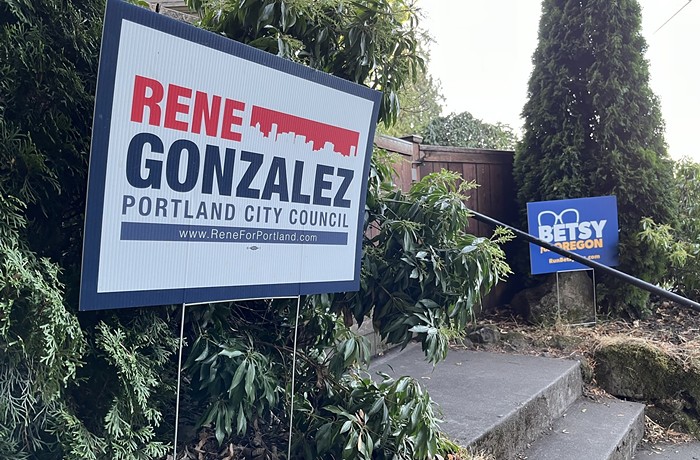UNLESS YOU'RE a desert hermit, incapable of perceiving the outside world, or willfully oblivious, you've probably noticed that Portland is changing. In previous decades this city's identity lay somewhere between "small city" and "very large town." Now there's no denying it: Portland is indeed a city, and it's getting bigger. And in 2025—10 years from now—it's going to be different still. It's not going to stop or pause based on panic or outcry. This evolution is an inevitability, and what follows are some of the best guesses from local experts about what it's all going to look like. (Like it or not.)
All of this assumes, of course, that a gigantic superquake hasn't leveled the Pacific Northwest and turned everything from Redding to Redmond into a Mad Max-ian, apocalyptic hellscape. In the event of seismic catastrophe, tsunami, or a zombie apocalypse, all bets are off.
Bigger Than Seattle?
"You should always be forecasting population growth," says Patrick Quinton, the executive director of the Portland Development Commission (PDC).
That's probably not terribly surprising for a lot of Portlanders to hear, but the data bears out both Quinton's opinion and popular sentiment. Since the mid-'70s, Portland has experienced a steady rise in population. In all likelihood that won't change, except for one thing: Portland of the future will probably be markedly more diverse than the Portland of today.

- Dan Lesage
"Half of school-age children aren't white," says Quinton. "The fastest growing groups in the city are non-white. This means, as a community, we need to get better at integrating."
Last year, Metro released a report estimating the Portland metro area could expect up to 725,000 new residents in the next 20 years, with the seven-county area topping three million. For context, that could make future Portland larger than present-day Seattle. A practical upshot is that we'll almost certainly be voting for an additional member of Congress in 10 years, which will do wonders for the button and lawn sign industries.
Locally, however, a larger population means an increase in demand for just about everything. And that one supposedly simple thing, demand, is a force that will level houses, raise towers, and change the fabric of the city.
Bigger, Taller, Denser, More
First, some good news. According to Tom Armstrong—a supervising planner for the Portland Bureau of Planning and Sustainability (BPS)—the city won't have to radically redraw its zoning map.

- Dan Lesage
"We haven't had to do a lot of up-zoning to accommodate current growth," he says. "We've been able to be strategic."
The BPS maintains a comprehensive plan for how Portland will grow over a 20-year period, and Armstrong's forecast for the next two decades is pretty straightforward.
"What we will see is a continuation of the recent development trends witnessed over the past 10 to 15 years," he says, "and really, that's been our plan—to see most of our growth focused either in the central city or along our mixed-use transit centers and corridors."
This should be of little surprise to anyone who has watched the transformation of SE Hawthorne, N Mississippi, and SE Division.
In the face of a larger population and more demand, single-family housing and single-story commercial space will find it more difficult to survive. The market will not bear a vacuum, or anything near it.
"You are going to see replacement of lower-density and lower-quality commercial properties," says Matthew Gebhardt, an associate professor of urban studies and planning at Portland State University. "There are a lot of single-story and parking lot-type places that will be replaced."
Quinton of the PDC agrees: "It's all gonna be about density. You're going to see a sharp push to demolish things that are low-density."
He also notes the buildings most likely to be demolished will be single-story commercial properties. If a commercial structure doesn't have offices, housing, or something above it, it's probably not long for this world. There is an undeniable pressure in Portland to build, build, and build.
That emphasis on density will also expand our current urban core. Since the 1970s, Portland has encouraged investment in a dense urban core, and especially, according to Gebhardt, the idea of a high-density core area near downtown.
"It's definitely going to get bigger," Gebhardt says. "If you look at the planning that's going on for the central city, they're thinking of it as a bigger area than just downtown, the Pearl, and the South Waterfront. It extends to the Eastside, the Lloyd District, Goose Hollow, Northwest, Slabtown. Planners are thinking about that as a whole area."
Armstrong of BPS is quick to quibble with this assessment. He says that yes, the area immediately around the urban core is creeping out, and Goose Hollow and the Burnside Bridgehead will probably look completely different in a few years, but...
"I would caution against saying the central city is expanding, because some people will assume we're going to include the Northwest district or Ladd's Addition," he says. "That's not what's in the plan."
There is one new area, though, that will officially be designated as part of the urban core.
"The only new spot would be an area called the Clinton Triangle—which is on the [TriMet] Orange Line that just opened," he says. "There's a small triangle at the Clinton Station that will be included within the city boundary, and the plan there is for more intensive development."
The Concrete Jungle
This expanding urban core and greater demand for real estate means that Portland will need to grow up—literally. Buildings are going to get taller.

- Dan Lesage
"The biggest change [in the last 10 years] is just the sheer increase in volume [of construction]," says Iain MacKenzie, the man behind nextportland.com, a website that tracks construction, demolition, and proposed buildings. "There was barely anything being built in Portland in 2009—but starting in 2012, multi-family construction began returning to levels last seen in the '00s. We're now at record highs for the number of multi-family buildings being permitted. There are single-family homes being built in Portland—but given that the city doesn't have large areas of vacant land ready to be subdivided, these represent a small fraction of the total units being built."
This push for density means buildings will get taller, which in turn means more concrete and steel in the urban core. Quinton points out downtown's Park Avenue West Tower (currently under construction) as a good example of what new commercial space can look like.
"In pre-recession Portland, office buildings got built when someone needed a new office. It was a very sleepy kind of market," he says.
That's changed, and the increased demand for office space means new types of architecture will become more prevalent.
"Portland has all these buildings that capped out at five stories, because that's about as high as you can build with wood," Quinton says. "After that you have to build with steel and concrete. So, you look around the city and you see all these building that are all the same height—particular in neighborhoods. That's because that's as high as they can build without switching to more expensive materials. When buildings go tall, it's because we can now generate the rents to justify the construction."
According to MacKenzie, however, wood buildings won't go entirely extinct. A few new buildings will still have timber frames—such as the proposed four-story office building at 4703 N Albina.
"These buildings are mostly targeted at smaller creative firms, rather than large corporate tenants," MacKenzie says. "They're all being built with exposed heavy timber framing—a construction method common in the 19th and early 20th centuries, but which have largely been replaced by steel or concrete construction."
In addition to office buildings, MacKenzie and Quinton also point out that Marriott, Hilton, and Hyatt all have hotels either in development or under construction in the city center. And, according to Quinton, industrial buildings are making a comeback as well.
"One of the challenges we've seen in terms of new commercial construction is that people generally don't build new industrial space—particularly in dense urban areas," he says. "If I'm going to build a three-story building, the rents I'm going to get on industrial space are a lot lower than what I'd get on commercial space. That's why we're trying to create incentives and models for developers to do more industrial."
One building, the New York in Northwest Portland, represents a potential precedent. Quinton characterizes it as the "first multi-story industrial building built within the city of Portland in 60 years... our thinking is that can be replicated. Multi-story industrial is coming back."
Mr. Developer's Neighborhood
When it comes to neighborhood development, the PDC is looking eastward for the future.
"We do see things going east," Quinton says. "We think Lents' town center is going to change a lot, and we're seeing a lot of changes across 82nd in neighborhoods like Cully—but I think it's going to go even farther east. One of our main goals is to help that change happen in a way that doesn't result in displacement."

- Dan Lesage
When asked how that can be accomplished, and how Lents, Cully, and other neighborhoods can grow without becoming another Division, Quinton says, "I don't think there's any substitute for creating affordable units."
Gebhardt says that for East Portland, the seemingly impossible goal of development without displacing people might actually be possible.
"The pattern of development is different," he says. "You don't have the same level of infrastructure there as in other areas, and the market demand isn't as strong."
Gebhardt notes that because of large lot sizes and a general lack of density in East Portland, there's potential for new housing to build up around what's already there.
Meanwhile, closer in, a dead zone previously known for chain restaurants and a mall might actually become a viable place to live, according to MacKenzie.
"The single biggest change is going to be the Lloyd District," he says, "which has historically been a shopping and business district, with very few residents. [Only 1,142 people as of the 2010 census.—Ed.] Between Hassalo on 8th, Oregon Square, the Union Apartments, and the Lloyd Cinemas redevelopment, there are thousands of units of housing planned or under construction. With them will come street-level retail, which is currently lacking in that neighborhood. And with the amount of developable land in that neighborhood, I don't think those will be the last projects either."
Gebhardt concurs with this prediction.
"In [areas like the Lloyd District] there's a lot of parking and empty space," he says. "You're going to see those fill in with mixed-use zoning. In fact, you're already seeing it."
Gebhardt adds that a typical building will probably have retail on the bottom floor, and then five or so stories of residential units on top.
"It will feel more like an actual neighborhood," he says.
According to Quinton, one of the major development companies in the Lloyd District, American Assets Trust, saw the neighborhood as undervalued—and, with not a lot of other activity going on, jumped in first to create a new real-estate market.
"Lloyd's always been close in," he says, "it just wasn't seen as having a lot of amenities. Now they're going to change that."
New housing is already underway in the Lloyd District, and BPS' Armstrong has a few estimates about where the next wave of development might pop up.
"In areas like Foster Road, 82nd, and upper Sandy we're seeing increasing property values. That's the natural next wave of development," he says. "The property values in residential neighborhoods surrounding those streets are going up, and there's strong demand for housing in those neighborhoods. And you're just starting to see early signs of development and reinvestment in existing businesses."
Land-Marked For Death!
Amidst all this growth, some buildings (maybe buildings you know and love) are going to die. In particular, two Portland monuments might not make it another 10 years.
"Probably the two most threatened buildings are Memorial Coliseum and the Multnomah County Courthouse," says MacKenzie. "The coliseum has a lot of deferred maintenance, and even just addressing that has been [estimated at] tens of millions. Upgrades that would bring the coliseum up to today's standards for an arena would cost even more."

- Dan Lesage
As for the courthouse...
"The city council still has to decide what action it's going to take—but they haven't ruled out demolition," MacKenzie says [Eds. note: the Multnomah County Board of Commissioners is actually the body weighing the fate of the courthouse]. "The courthouse is built with unreinforced hollow clay tile, a building material that will crumble in even a relatively mild earthquake. It's probably at least five years before the county vacates it, when they will probably sell it off as surplus."
When asked about the courthouse, Quinton simply says "that structure has very little purpose, given its seismic condition."
Buildings on the National Register of Historic Places (like the embattled Portland Building) are probably safe.
"When demolition is proposed for a building notable enough to be on the National Register of Historic Places," says MacKenzie, "or listed as contributing in a historic district, it has to go through city council. The only demolitions they've approved are the Dirty Duck Tavern [in 2010], and more recently the partial demolition of the Washington Park reservoirs. What's much more common is the loss of single-family homes that aren't notable enough to be on the National Register. In areas with residential zoning, there's a mandatory delay period—but this doesn't apply in areas with commercial/mixed zoning."
If the PDC gets its way, the downtown post office will certainly be gone in 10 years.
"If we acquire the post office site," says Quinton, "our goal is to replace the existing structures with a dense mixed-use and mixed-income neighborhood."
However, Quinton also notes this isn't necessarily a sure thing, and cites the PDC's continuing struggle with the still-standing Centennial Mills as a potential counter example.
"We acquired that property 15 years ago with the intent to demo it," he says. "Here we are 15 years later, and only now beginning the demo."
A Model Portland

- KM
In the midst of all that construction, density, and population growth, Quinton emphasizes there's no specific model for Portland to follow. There's no city whose experience sufficiently matches ours, thereby allowing us to follow in their path.
"We talk a lot about the models we don't want to follow, and certainly San Francisco is at the top of that list," says Quinton. "That's what's scary about this moment. We look around the country and don't see any other cities that got ahead of it in time. They've had to figure out how to unwind what they've done."
This article has been changed from its original version to reflect that only Washington Park's water reservoirs will be partly demolished. Mt. Tabor's will be left in place.














